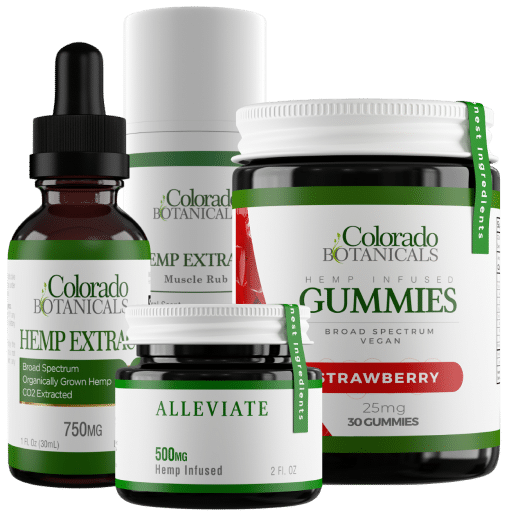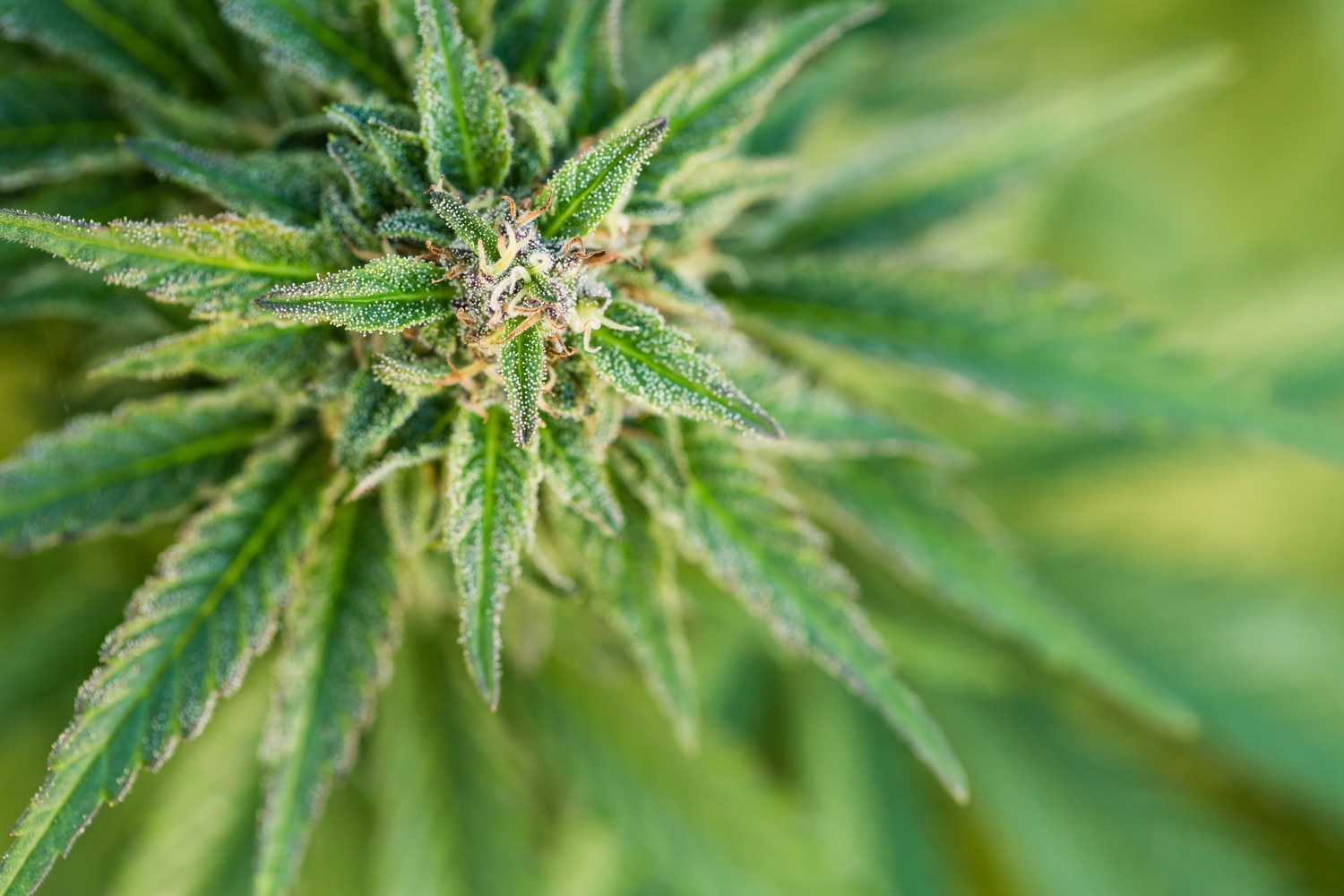Cannabigerol (CBG) isn’t among the most well-known cannabinoids. Odds are you’re reading this because of its recent mainstream attention. Still, CBG is one of the unique compounds in a cannabis plant. Despite its very low concentrations, all major and minor cannabinoids wouldn’t exist without CBG.
But as hemp-derived CBG oils become mainstream, the CBG vs. CBD debate is emerging. What is CBG? Is it like CBD? What are the potential benefits of CBG products?
What is CBG?
Like THC, we’ve known of CBG since the 1960s. But thanks to worldwide restrictions on research and possession, studies into the cannabinoid are few and far between.
CBG is similar to CBD in many respects – the most important one being lack of intoxication. And like CBD, vendors can isolate CBG using the same clean and trusted methods as its more popular counterpart.
Still, there are a few key things we know (which we’ll cover in this article), such as CBG’s origins, unique properties, and potential benefits. However, it’s no secret that CBG – like CBD – could have a bright future in the world of dietary supplements. 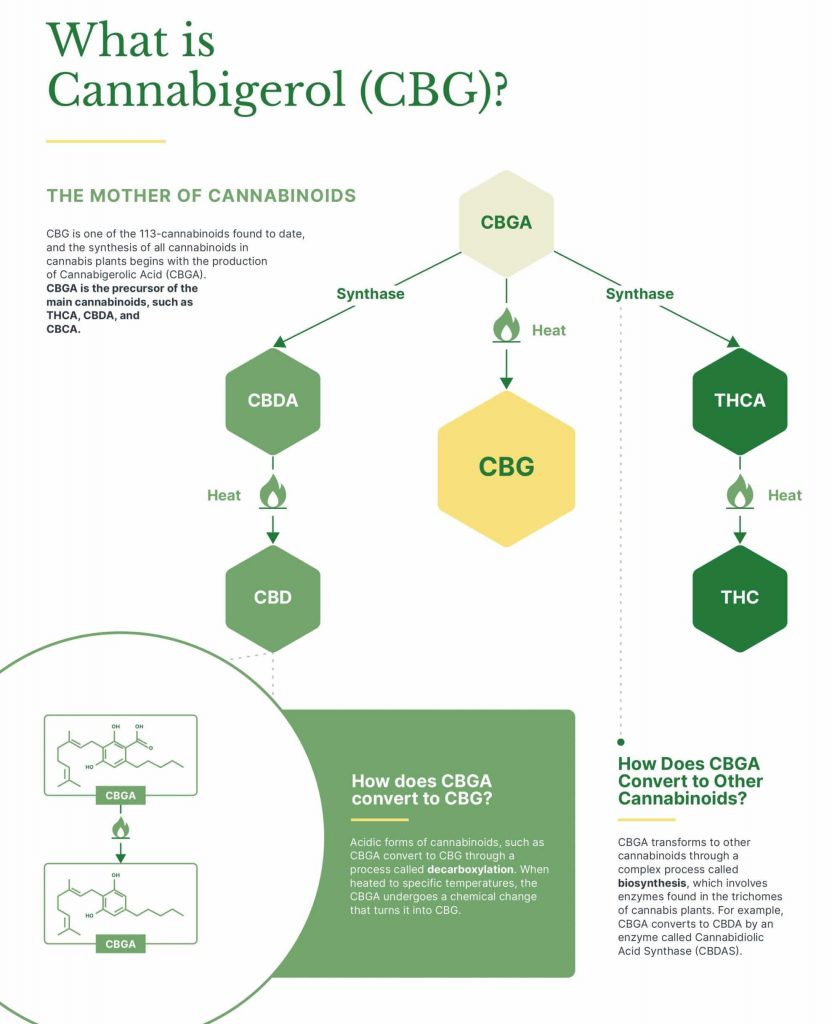
CBG is the “Stem Cell Cannabinoid”
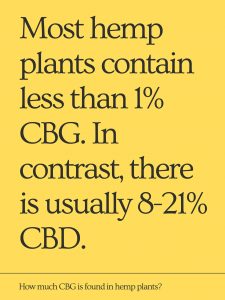 Much like how stem cells – generally defined – are the precursors to all of the body’s other cells, CBG works the same way. According to PR Newswire, “CBG is the main element that the other cannabinoids are created from, hence being commonly referred to as the ‘stem cell.'”
Much like how stem cells – generally defined – are the precursors to all of the body’s other cells, CBG works the same way. According to PR Newswire, “CBG is the main element that the other cannabinoids are created from, hence being commonly referred to as the ‘stem cell.'”
Since all cannabinoids start as CBG, you’ll find higher concentrations in young cannabis plants. When fully grown, most cannabis plants contain very low levels of CBG – around 1%.
Recently, some hemp farmers began selectively cultivating to obtain higher yields of Cannabigerol, creating higher concentrations of CBG in the resulting strains.
Like all cannabinoids, cannabis plants contain CBG in an inert acidic form called Cannabigerolic acid (CBGA). Similarly, THC and CBD start as tetrahydrocannabinolic acid (THCA) and cannabidiolic acid (CBDA).
Applying heat triggers a process called “decarboxylation,” which removes the acidity and turns CBGA into active CBG.
How Is CBG Made?
We make CBG in the same fashion as conventional cannabis extracts. The only difference is that producers focus on Cannabigerol instead of THC or CBD.
Some methods are better (and older) than others, so it’s essential to understand the differences and how they can impact the product – not to mention your health.
Hydrocarbon Extraction
Hydrocarbon (butane) extraction is standard for high-THC cannabis concentrates, like butane hash oil (BHO). However, it’s unnecessary for regular oils, hemp-derived or otherwise.
Reputable hemp oil vendors don’t use hydrocarbon because of concerns about trace solvents. Informed customers also understand the risks and avoid products like the plague.
Alcohol
As the name implies, alcohol is another way to separate CBG from plant material. However, like hydrocarbon methods, alcohol can also leave behind trace solvents.
While skilled manufacturers can properly filter these traces to safe levels (with lab reports to prove it), it’s still not the cleanest option available.
CO2
Carbon dioxide extraction is the best way to make CBG oil or any related cannabis extract. Unlike hydrocarbon and alcohol separation, CO2 naturally filters itself out during the separation process.
As a result, there’s no chance of trace solvents in the final product. As a bonus, low-temperature CO2 extraction also offers the best performance for retaining terpenes and cannabinoids.
What Recent Studies Say About the Benefits of CBG
Like with most cannabinoid medicines, CBG research is still in its early stages – even though its existence has been known for about half a century. However, our understanding of the endocannabinoid system and medical cannabis is limited.
Still, preliminary evidence points to many of CBG’s potential therapeutic effects in stopping cancer cells, reducing chronic inflammation, treating glaucoma, and more. CBG oil and other CBG products derived from hemp plants could also boost overall wellness as supplements.
CBG & Anti-Tumor
There’s been a long-suspected link between cannabis and cancer reduction. Research isn’t conclusive yet, but current evidence suggests CBG may impede cancer cell growth.
According to the authors, a 2021 study published in the National Library of Medicine tested Cannabigerol (CBG) on glioblastoma – the most aggressive type of primary brain tumor.
According to the study, researchers individually tested CBG and CBD. However, they also tried two combinations. One was CBG and THC, while their second formula mixed CBG and CBD.
The observers noticed that CBG encouraged cell death and reduced the condition’s invasive tendencies. They also reminded us how CBG is non-intoxicating, unlike THC.
CBG & Inflammation
CBD is known for its anti-inflammatory properties, but does CBG do the same? A 2013 study in the National Library of Medicine examined Cannabigerol’s potential benefits against experimental inflammatory bowel disease. Specifically, they looked at mice with colitis.
The study noted that CBG interacts with the CB2 endocannabinoid receptors, which they believed helped reduce inflammation and oxidative stress. They also noticed a downward change in nitric oxide production. This observation is particularly revealing since nitric oxide production is a sign of some types of inflammation.
Although we need more research, the data indicates CBG as a potential treatment for inflammatory bowel disease.
Another study, conducted in 2015 by Pagano et al., examined how different cannabinoids affect individuals with bladder dysfunctions.
The results showed CBG was the most effective at reducing bladder contractions, often associated with conditions like overactive bladder.
With more research, CBG may be a valuable tool in treating bladder dysfunctions.
CBG & Glaucoma
High THC medical cannabis has been prescribed for glaucoma (where legal) for quite some time. But 1990 research published in the Journal of Ocular Pharmacology and Therapeutics demonstrates CBG might provide similar benefits.
The experts experimented separately with THC and CBG, administering it directly to the eyes of feline test subjects. They noticed only a slight improvement with THC and CBG alone. But the results were drastically different when both THC and CBG were combined.
The study points out “…a considerable fall in ocular tension,” further explaining how those “…results suggest that Cannabigerol and related cannabinoids may have therapeutic potential for treating glaucoma.
CBG & Antibacterial Properties
Concerns over antibiotic-resistant bacteria have been in the news for a while, with some doctors calling this trend a severe threat that can impede modern medicine. However, the cannabis plant may offer a novel way to deal with bacterial infections.
Cannabigerol is one of several cannabinoids believed to have antimicrobial benefits. If so, cannabinoids could be a solution for these “superbugs.”
2008 study published in the Journal of Natural Products examined the effects of several cannabinoids on drug-resistant staph infections (Methicillin-resistant Staphylococcus aureus – MRSA). According to the publication, “All five major cannabinoids (cannabidiol), Cannabichromene, Cannabigerol, Tetrahydrocannabinol, and Cannabinol showed potent activity against a variety of methicillin-resistant Staphylococcus aureus (MRSA) strains of current clinical relevance.”
We’ll need more research into cannabis plants before the medical community considers cannabinoids for treating bacterial infections.
CBG & Huntington’s Disease
Huntington’s disease is a degenerative brain disease caused by a single defective gene. Currently, there’s no way to prevent or cure Huntington’s disease. However, some evidence suggests CBG may have neuroprotective properties.
A 2015 study in Neurotherapeutics examined Cannabigerol’s effects on mice with Huntington’s disease. The observers noticed antioxidant effects, which are critical for protecting the brain and slowing down the disease’s degenerative process.
Ultimately, the experts concluded that Cannabigerol might have medicinal benefits for many neurodegenerative conditions. Still, we need human clinical trials.
How CBG Works and Interacts with Our Cannabinoid Receptors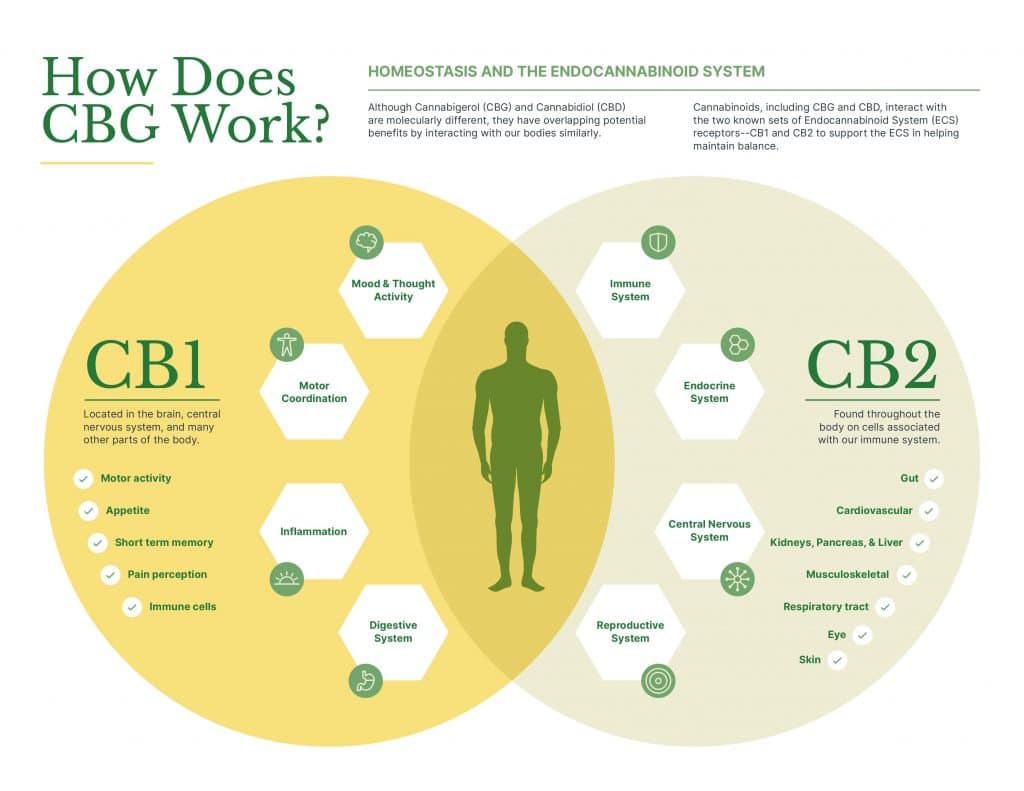 To understand how CBG works, we need to talk about the body’s Endocannabinoid System (ECS).
To understand how CBG works, we need to talk about the body’s Endocannabinoid System (ECS).
Cannabigerol is an example of a phytocannabinoid, referring to cannabinoids found exclusively outside the human body.
However, we also have several ones, created internally, known as endocannabinoids. These compounds play a crucial role in maintaining homeostasis, a state of internal balance. When something is wrong, endocannabinoids signal the body to correct it.
But sometimes, the ECS needs some outside help, which is where phytocannabinoids like CBD, THC, and CBG come in.
Although cannabinoids often interact with other receptors, the two we want to focus on are CB1 and CB2. CB1 receptors are primarily located in the central nervous system, while CB2 receptors sit mainly in the peripheral systems.
So which endocannabinoid receptors work with CBG? According to one 2017 review of existing literature by Aloway et al., Cannabigerol binds with the CB1 and CB2 varieties.
Cannabigerol is a “partial agonist” to both the CB1 and CB2 receptors. This means that, while it supports their function to a degree, it’s not nearly as strong as a complete agonist.
Does CBG Get You High?
No. CBG doesn’t get you high. Like CBD, Cannabigerol has no psychoactive effects – at least not in terms of intoxication. Many cannabinoids bind with CB1, but the only cannabinoid that binds strongly enough to get you high is THC.
THC is the only cannabinoid known to cause strong intoxication, with cannabinol (CBN) triggering milder psychotropic effects.
What Does CBG Feel Like?
The few studies available focus on CBG’s therapeutic benefits and safety rather than the experience. To understand what CBG feels like, we need to look at anecdotes. Fortunately, the Internet has no shortage of those insights.
Reddit is famous for its niche forums, including a subreddit called r/hempflower. The original poster asked people to share their CBG experiences, which seemed mixed.
Reddit user u/NixiePixie says:
“Caffeine. It feels like caffeine to me, whereas CBD feels calming. When I drink coffee, I take CBD, so I don’t feel the way CBG makes me feel.”
User u/robdowns78 wasn’t impressed with CBG alone and felt it needed some backup:
“I don’t get much of an effect from CBG by itself. When mixed with CBD or THC, it is a potentiator. It also does an amazing job on headaches.”
Similarly, u/CervicalCBD echoed u/robdowns78:
“I don’t feel much unless I mix it with CBD. It completes it and gives me extra motivation to start my day.”
According to u/EllieMayNot10, Cannabigerol doesn’t compare to CBD:
“Most start with CBD, and, honestly, that would be my recommendation…I do use CBG in comparatively smaller amounts, but it does not accomplish half of what CBD does for me.”
Finally, Reddit user u/WOLFXXXXXX explains:
“Mostly notice the psychological effects – which I would describe as promoting a calm and very sharp/focused mental state that doesn’t feature any element of sedation… Seems like a good option for daytime use when one needs to remain alert & focused…After a couple of orders, I got tired of dealing with naturally bone-dry CBG flower and just started ordering the CBG kief to add to CBD or THC flower, which I find much easier to manage.
While reviews are primarily positive, it seems there’s a common trend that CBG alone isn’t as effective as when combined with other cannabinoids.
CBD vs. CBG: Similarities and Differences
Cannabinoids share similarities and differences, with THC standing out from the crowd for its unparalleled intoxicating effects.
But for hemp-derived cannabis, health enthusiasts are comparing CBG and CBD products. Both CBG and CBD may have a lot to offer.
However, which is compound is better? What are the most unusual ways they differ? Here are some quick similarities and differences between CBG and CBD.
Similarities
Based on the research, CBG shares some notable similarities with CBD. A few includes:
- Anti-inflammatory
- Appetite stimulation
- Inhibit cancer cell growth
- Increased energy and focus
- Antioxidant
- Neuroprotective
- Analgesic
Differences
The list of differences is a bit smaller, but this isn’t a surprise. Most cannabinoids have overlapping effects on the brain and body. Some fundamental ways CBG differs from CBD are:
- Potency (CBD appears to be more effective)
- Barely present in mature cannabis plants
- Antibacterial properties
- More potent mental effects than CBD
- Weaker for peripheral issues, like pain
- Needs other cannabinoids (THC or CBD) for best results
Is CBG Better Than CBD?
Is CBD or CBG Better? That’s an excellent question to ask, but if you’re looking for an answer, we’re sorry to disappoint you. As we’ve seen, CBD and CBG have many overlapping properties, with CBG outdoing its counterpart when it comes to cerebral effects.
Ultimately, CBG can be better than CBD based on your needs. CBG reportedly works well for increased energy and focus, while CBD works better on peripheral issues, like muscle and joint pain (although both play a role in those areas).
How to Use CBG?
You use CBG just like you would with any CBD product, with three main consumption methods:
- CBG oil
- CBG vapes
- CBG edibles
Oil and edibles are meant for ingestion without oil taken under the tongue before swallowing. Vaping CBG allows you to inhale the product, providing almost immediate relief.
How Much CBG to Take?
No concrete dosage guidelines are available for CBG or any other cannabinoids. The best approach is to use the “start low and go slow method.”
Begin with the smallest dose possible, then gradually increase it over several days. Once you notice the desired effects, maintain that dose. CBG dosing is quite similar to CBD dosing, but CBG doesn’t produce as noticeable effects or feelings as CBD but still benefits the body.
Does CBG Cause Any Side Effects?
It’s unknown whether CBG has side effects. A review from February 2021 in the Journal of Pharmacology and Experimental Therapeutics discusses some roadblocks to research on CBG’s side effects:
“…very few Cannabis strains actually harbor large concentrations of CBG, so there is not much prior reporting (and virtually no documentation) of human side effects of CBG.”
If you use CBG, monitor yourself for side effects. Don’t take CBG without first speaking to a doctor as a precaution.
Using CBG Oil and Prescription Medications
The February 2021 study above notes potential interactions with heart medications, noting increased sedation and blood pressure changes. According to the authors:
“Finally, there is also the very real risk of inducing drug-drug interactions when over-the-counter preparations like CBD oil or CBG oil are taken by a patient on other (prescription) medications. This may lead to unintended adverse consequences when not appropriately monitored.”
Using CBG Oil and Prescription Medications
Since limited research has been conducted on the effects of CBG oil and its interactions with prescription medications, more clinical studies are still needed before we have a better understanding. Despite this, Cannabigerol has been shown to offer anti-inflammatory and antibiotic properties; therefore, it’s safe to assume that CBG may have an interaction with the medications listed below:
- Anticancer medications
- Prostate medications
- Antiepileptic drugs (AEDs)
- Heart rhythm medications
- Blood thinners
- Corticosteroids
- Erectile dysfunction medications
- Cholesterol medications
- Gastrointestinal medications
- Prostate medications
- Antihistamines
- Mood medications
- Pain killers (analgesics)
- Blood pressure medications
- Antimicrobials and antibiotics
Where to Buy CBG Oil?
Hopefully, you’re excited about CBG. But given its relatively new presence in the hemp oil niche, finding the best product can be an ordeal. Your best bet is to buy from an already established CBD oil vendor.
But if you decide to try CBG from a new source, make sure they’re transparent. Specifically, look for third-party lab reports. They should be readily available and easy to read.
Colorado Botanicals, for instance, sets an excellent example for simple, informative lab reports. Check them out if you’re unsure how these papers should look. They offer both 750mg CBG Oil and 1,500mg CBG Oil with a 1:1 ratio of CBD and CBG. So the 750mg CBG Oil contains 375mg of CBD and 375mg of CBG, while the 1,500mg CBG Oil contains 750mg of CBD and 750mg of CBG, along with other minor cannabinoids and terpenes naturally extracted from the plant.
Is CBG The New CBD?
No, CBG isn’t the new CBD – at least not yet. CBD works well on its own, but CBG seems to have mixed reviews, with users often saying they have to combine CBG with CBD or THC for the best results.
With time, genetic manipulation of industrial hemp for CBG production, along with a renewed interest, might help vendors refine these products to make them more effective.
Sources
Pagano E, Montanaro V, Di Girolamo A, Pistone A, Altieri V, Zjawiony JK, Izzo AA, Capasso R. Effect of Non-psychotropic Plant-derived Cannabinoids on Bladder Contractility: Focus on Cannabigerol. Nat Prod Commun. 2015 Jun;10(6):1009-12. PMID: 26197538.
Aloway, A., Kumar, A., Laun, A. S., & Song, Z. H. (2017). Cannabinoid regulation of intraocular pressure: Human and animal studies, Cellular and molecular targets. Handbook of Cannabis and Related Pathologies, 748–759. https://doi.org/10.1016/b978-0-12-800756-3.00088-0
Appendino, G., Gibbons, S., Giana, A., Pagani, A., Grassi, G., Stavri, M., Smith, E., & Rahman, M. M. (2008). Antibacterial cannabinoids from cannabis sativa: A structure−activity study. Journal of Natural Products, 71(8), 1427–1430. https://doi.org/10.1021/np8002673
Borrelli, F., Fasolino, I., Romano, B., Capasso, R., Maiello, F., Coppola, D., Orlando, P., Battista, G., Pagano, E., Di Marzo, V., & Izzo, A. A. (2013). Beneficial effect of the non-psychotropic plant cannabinoid cannabigerol on experimental inflammatory bowel disease. Biochemical Pharmacology, 85(9), 1306–1316. https://doi.org/10.1016/j.bcp.2013.01.017
COLASANTI, B. R. E. N. D. A. K. (1990). A comparison of the ocular and central effects of Δ9-tetrahydrocannabinol and Cannabigerol. Journal of Ocular Pharmacology and Therapeutics, 6(4), 259–269. https://doi.org/10.1089/jop.1990.6.259
FinancialNewsMedia.com. (2020, May 11). CBG called the ‘stem cell’ of cannabinoids and could be more profitable than CBD. CBG Called the ‘Stem Cell’ Of Cannabinoids and Could be More Profitable Than CBD. Retrieved December 17, 2021, from https://www.prnewswire.com/news-releases/cbg-called-the-stem-cell-of-cannabinoids-and-could-be-more-profitable-than-cbd-301056377.html
Huntington’s disease. Alzheimer’s Disease and Dementia. (n.d.). Retrieved December 17, 2021, from https://www.alz.org/alzheimers-dementia/what-is-dementia/types-of-dementia/huntington-s-disease
Lah, T. T., Novak, M., Pena Almidon, M. A., Marinelli, O., Žvar Baškovič, B., Majc, B., Mlinar, M., Bošnjak, R., Breznik, B., Zomer, R., & Nabissi, M. (2021). Cannabigerol is a potential therapeutic agent in a novel combined therapy for glioblastoma. Cells, 10(2), 340. https://doi.org/10.3390/cells10020340
Nachnani, R., Raup-Konsavage, W. M., & Vrana, K. E. (2020). The pharmacological case for Cannabigerol. Journal of Pharmacology and Experimental Therapeutics, 376(2), 204–212. https://doi.org/10.1124/jpet.120.000340
Valdeolivas, S., Navarrete, C., Cantarero, I., Bellido, M. L., Muñoz, E., & Sagredo, O. (2014). Neuroprotective properties of Cannabigerol in Huntington’s disease: Studies in R6/2 mice and 3-nitropropionate-lesioned mice. Neurotherapeutics, 12(1), 185–199. https://doi.org/10.1007/s13311-014-0304-z



